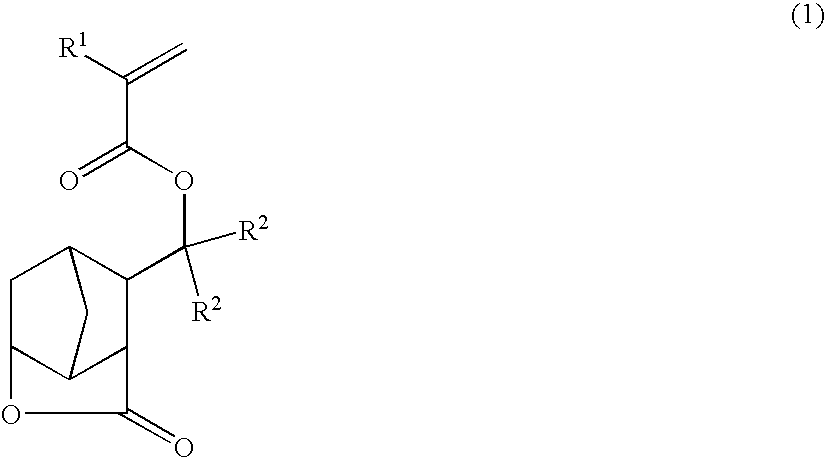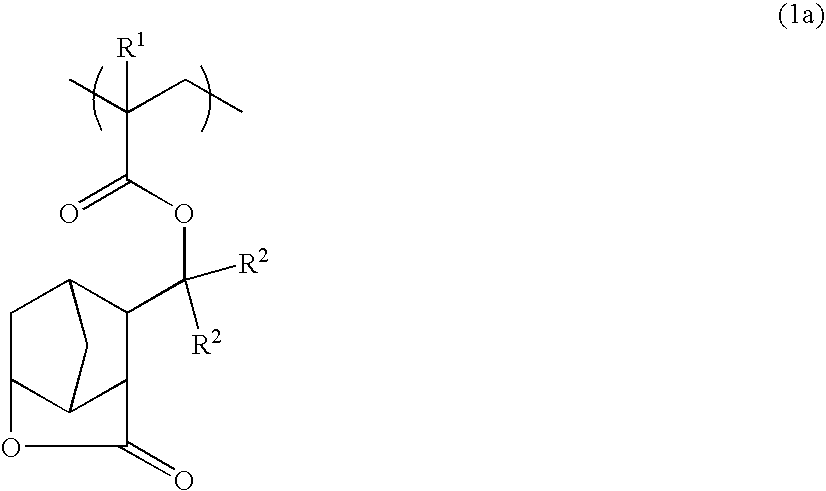Novel tertiary (meth)acrylates having lactone structure, polymers, resist compositions and patterning process
a technology of tertiary (meth) acrylates and lactone structure, applied in the direction of photosensitive materials, instruments, photomechanical equipment, etc., can solve the problems of unsatisfactory resins, unsatisfactory resist materials, and inability to meet the requirements of practically acceptable resist materials, etc., to achieve improved adhesion, transparency, etching resistance and resolution
- Summary
- Abstract
- Description
- Claims
- Application Information
AI Technical Summary
Benefits of technology
Problems solved by technology
Method used
Image
Examples
example 1
[0435] Synthesis of 3-(1-methacryloyloxy-1-methylethyl)-2,6-norbornanecarbolactone (i.e., methacrylate of formula (1) wherein R1=R2=methyl)
[0436] With stirring in nitrogen and at 0° C., a THF solution of 860 mmol methylmagnesium chloride was added to a solution of 80 g methyl 2,6-norbornanecarbolactone-3-carboxylate of formula (4) in 500 ml THF. The solution was stirred for one hour. An aqueous solution of ammonium chloride was added to stop the reaction, followed by conventional aqueous work-up. The solvent was distilled off in vacuo, yielding 3-(1-hydroxy-1-methylethyl)-2,6-norbornanecarbolactone of formula (7).
[0437] Next, to a mixture of the thus obtained 3-(1-hydroxy-1-methylethyl)-2,6-norbornanecarbolactone, 70 g of triethylamine and 400 g of dichloromethane, under ice cooling and with stirring, 55 g of methacryloyl chloride was added. The solution was stirred at room temperature for 12 hours. Water was added to stop the reaction, followed by conventional aqueous work-up. T...
example 2
[0438] Synthesis of 3-(1-acryloyloxy-1-methylethyl)-2,6-norbornanecarbolactone (i.e., acrylate of formula (1) wherein R1=hydrogen, R2=methyl)
[0439] By following the same procedure as in Example 1 except that 50 g of acryloyl chloride was used instead of the methacryloyl chloride, 3-(1-acryloyloxy-1-methylethyl)-2,6-norbornanecarbolactone of formula (9) was synthesized. The yield of compound (9) was 76% based on the methyl 2,6-norbornanecarbolactone-3-carboxylate.
example 3
[0440] Synthesis of a polymer having the structural formula (10) wherein x=z=0.35, y=0.30
[0441] In a nitrogen atmosphere, a mixture of 9.2 g of the methacrylate (8) obtained in Example 1, 7.4 g of 2-ethyl-2-adamantyl methacrylate, 8.3 g of 3-hydroxy-1-adamantyl methacrylate, 60 mg of N,N′-azobisisobutyronitrile, and 80 ml of THF was heated and stirred at 60° C. for 20 hours. After cooling, the reaction mixture was added dropwise to 2 liters of methanol under vigorous stirring. The precipitate which settled down was collected by filtration. The solids were washed with methanol and dried in vacuo, obtaining 19.9 g of the desired polymer. The yield was 80%. An integration ratio calculated from its 1H-NMR spectrum indicated a copolymerization ratio of approximately 35:30:35. GPC analysis using polystyrene standards indicated a weight average molecular weight (Mw) of 9,800 and a polydispersity index (Mw / Mn) of 1.80.
PUM
| Property | Measurement | Unit |
|---|---|---|
| Fraction | aaaaa | aaaaa |
| Nanoscale particle size | aaaaa | aaaaa |
| Molecular weight | aaaaa | aaaaa |
Abstract
Description
Claims
Application Information
 Login to View More
Login to View More - R&D
- Intellectual Property
- Life Sciences
- Materials
- Tech Scout
- Unparalleled Data Quality
- Higher Quality Content
- 60% Fewer Hallucinations
Browse by: Latest US Patents, China's latest patents, Technical Efficacy Thesaurus, Application Domain, Technology Topic, Popular Technical Reports.
© 2025 PatSnap. All rights reserved.Legal|Privacy policy|Modern Slavery Act Transparency Statement|Sitemap|About US| Contact US: help@patsnap.com



